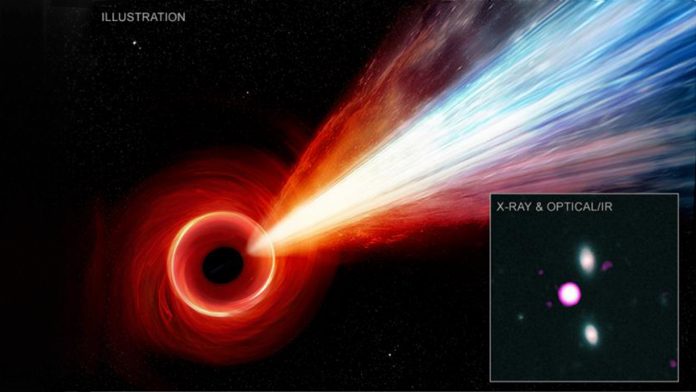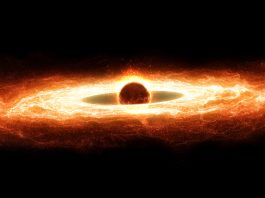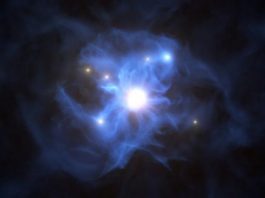Astronomers using NASA’s Chandra X-ray Observatory have discovered evidence of a long jet of particles coming from a supermassive black hole in the early Universe.
This could be the most distant supermassive black hole with a jet detected in X-rays. Coming from a galaxy about 12.7 billion light-years from Earth, the jet may help explain how the biggest black holes formed at a very early time in the Universe’s history.
The source of the jet is a quasar, named PSO J352.4034-15.3373 (PJ352-15 for short), which sits at the centre of a young galaxy. It is one of the two most powerful quasars detected in radio waves in the first billion years after the Big Bang, and is about a billion times more massive than the Sun.
The team observed PJ352-15 for three days using the sharp vision of Chandra to detect evidence for the X-ray jet. X-ray emission was detected about 160,000 light-years away from the quasar along the same direction as much shorter jets previously seen in radio waves by the Very Long Baseline Array.
PJ352-15 breaks a couple of different astronomical records. First, the longest jet previously observed from the first billion years after the Big Bang was only about 5,000 light-years in length, corresponding to the radio observations of PJ352-15. Second, PJ352-15 is about 300 million light-years farther away than the most distant X-ray jet recorded before it.
Co-author Eduardo Bañados of the Max Planck Institute for Astronomy (MPIA) in Heidelberg, Germany, said: “The length of this jet is significant because it means that the supermassive black hole powering it has been growing for a considerable period of time. This result underscores how X-ray studies of distant quasars provide a critical way to study the growth of the most distant supermassive black holes.”
How old is this jet?
The light detected from this jet was emitted when the Universe was only 0.98 billion years old, less than a tenth of its present age. At this point, the intensity of the cosmic microwave background radiation left over from the big bang was much greater than it is today.
As the electrons in the jet fly away from the black hole at close to the speed of light, they move through and collide with photons making up the cosmic microwave background radiation, boosting the energy of the photons up into the X-ray range to be detected by Chandra. In this scenario, the X-rays are significantly boosted in brightness compared to radio waves. This agrees with the observation that the large X-ray jet feature has no associated radio emission.
Co-author Daniel Stern said: “Our result shows that X-ray observations can be one of the best ways to study quasars with jets in the early Universe. Or to put it another way, X-ray observations in the future may be the key to unlocking the secrets of our cosmic past.”









